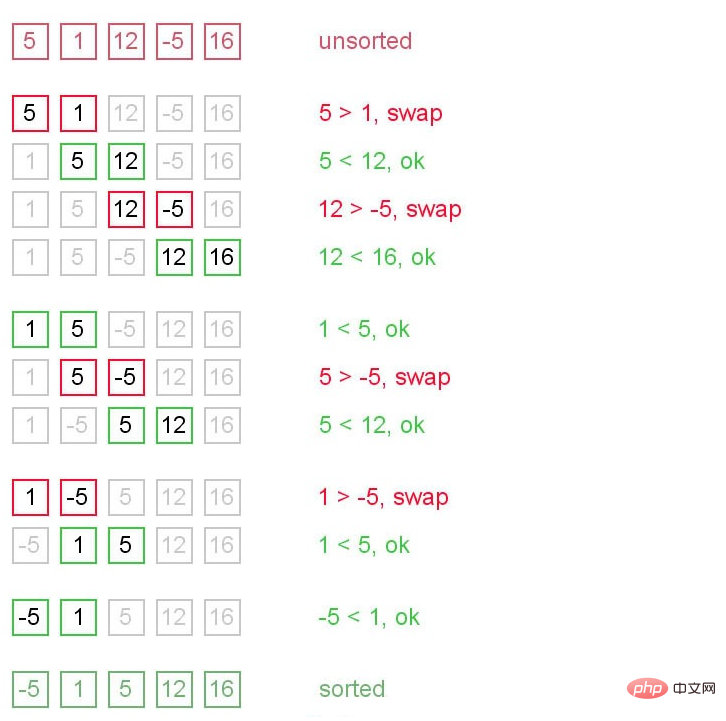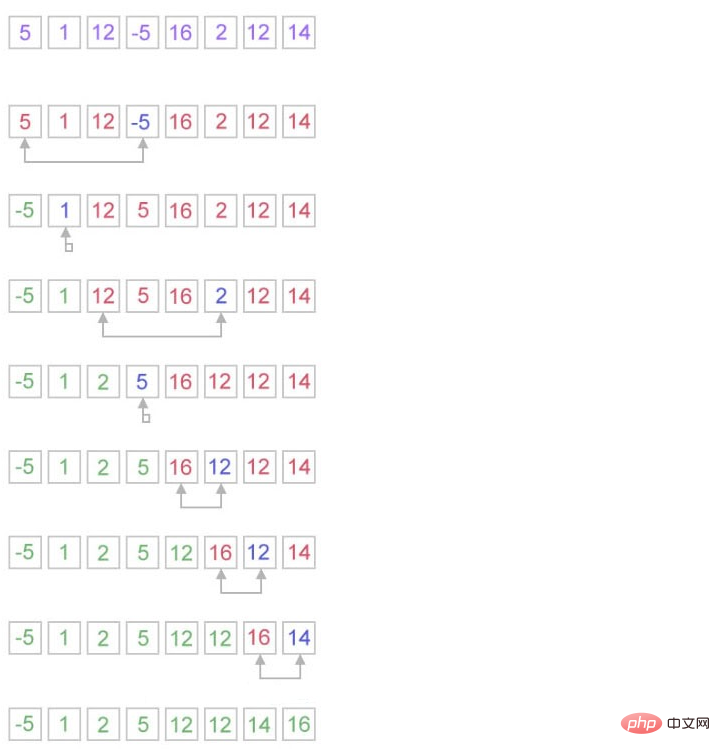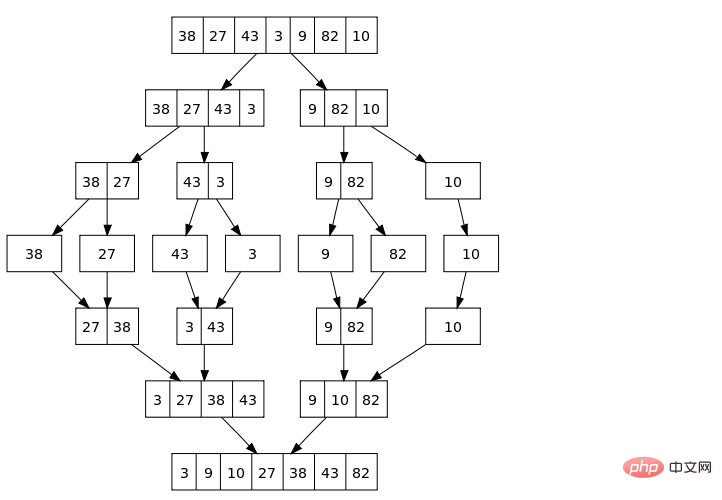
推薦教學:java教學
# 在計算器科學與數學中,一個排序演算法(英文:Sorting algorithm)是一種能將一串資料依照特定排序方式排列的演算法。本文將總結幾類常用的排序演算法,包括冒泡排序、選擇排序、插入排序、快速排序和歸併排序。
1、冒泡排序
#原理圖

理解:透過重複地遍歷要排序的列表,比較每對相鄰的項目,並在順序錯誤的情況下交換它們。
#程式碼:public class BubbleSort {
// logic to sort the elements
public static void bubble_srt(int array[]) { int n = array.length; int k; for (int m = n; m >= 0; m--) { for (int i = 0; i < n - 1; i++) {
k = i + 1; if (array[i] > array[k]) {
swapNumbers(i, k, array);
}
}
printNumbers(array);
}
}
private static void swapNumbers(int i, int j, int[] array) {
int temp;
temp = array[i]; array[i] = array[j]; array[j] = temp;
}
private static void printNumbers(int[] input) {
for (int i = 0; i < input.length; i++) {
System.out.print(input[i] + ", ");
}
System.out.println("\n");
}
public static void main(String[] args) { int[] input = { 4, 2, 9, 6, 23, 12, 34, 0, 1 };
bubble_srt(input);
}
}
2、選擇排序

理解:內部循環尋找下一個最小(或最大)值,外部循環將該值放入其適當的位置。
程式碼:public class SelectionSort {
public static int[] doSelectionSort(int[] arr){
for (int i = 0; i < arr.length - 1; i++)
{ int index = i; for (int j = i + 1; j < arr.length; j++) if (arr[j] < arr[index])
index = j;
int smallerNumber = arr[index];
arr[index] = arr[i];
arr[i] = smallerNumber;
} return arr;
}
public static void main(String a[]){
int[] arr1 = {10,34,2,56,7,67,88,42}; int[] arr2 = doSelectionSort(arr1); for(int i:arr2){
System.out.print(i);
System.out.print(", ");
}
}
}
3、插入排序
原理圖片
理解:每一步將一個待排序的記錄,插入到前面已經排好序的有序序列中去,直到插完所有元素為止。
程式碼:public class InsertionSort {
public static void main(String a[]){ int[] arr1 = {10,34,2,56,7,67,88,42}; int[] arr2 = doInsertionSort(arr1); for(int i:arr2){
System.out.print(i);
System.out.print(", ");
}
}
public static int[] doInsertionSort(int[] input){
int temp; for (int i = 1; i < input.length; i++) { for(int j = i ; j > 0 ; j--){ if(input[j] < input[j-1]){
temp = input[j]; input[j] = input[j-1]; input[j-1] = temp;
}
}
} return input;
}
}
原理圖
理解:將原問題分解為若干個規模更小,但結構與原問題相似的子問題,遞歸地解這些子問題,然後將這些子問題的解組合為原問題的解。
程式碼:public class QuickSort {
private int array[]; private int length;
public void sort(int[] inputArr) {
if (inputArr == null || inputArr.length == 0) { return;
} this.array = inputArr;
length = inputArr.length;
quickSort(0, length - 1);
}
private void quickSort(int lowerIndex, int higherIndex) {
int i = lowerIndex; int j = higherIndex; // calculate pivot number, I am taking pivot as middle index number
int pivot = array[lowerIndex+(higherIndex-lowerIndex)/2]; // Divide into two arrays
while (i <= j) { /**
* In each iteration, we will identify a number from left side which
* is greater then the pivot value, and also we will identify a number
* from right side which is less then the pivot value. Once the search
* is done, then we exchange both numbers.
*/
while (array[i] < pivot) {
i++;
} while (array[j] > pivot) {
j--;
} if (i <= j) {
exchangeNumbers(i, j); //move index to next position on both sides
i++;
j--;
}
} // call quickSort() method recursively
if (lowerIndex < j)
quickSort(lowerIndex, j); if (i < higherIndex)
quickSort(i, higherIndex);
}
private void exchangeNumbers(int i, int j) { int temp = array[i]; array[i] = array[j]; array[j] = temp;
}
public static void main(String a[]){
MyQuickSort sorter = new MyQuickSort(); int[] input = {24,2,45,20,56,75,2,56,99,53,12};
sorter.sort(input); for(int i:input){
System.out.print(i);
System.out.print(" ");
}
}
}
5、歸併排序

理解:將待排序的數列分成若干個長度為1的子數列,然後將這些數列兩兩合併;得到若干個長度為2的有序數列,再將這些數列兩兩合併;得到若干個長度為4的有序數列,再將它們兩兩合併;直接合併成一個數列為止。
###程式碼:######public class MergeSort {
private int[] array; private int[] tempMergArr; private int length;
public static void main(String a[]){
int[] inputArr = {45,23,11,89,77,98,4,28,65,43};
MyMergeSort mms = new MyMergeSort();
mms.sort(inputArr); for(int i:inputArr){
System.out.print(i);
System.out.print(" ");
}
}
public void sort(int inputArr[]) { this.array = inputArr; this.length = inputArr.length; this.tempMergArr = new int[length];
doMergeSort(0, length - 1);
}
private void doMergeSort(int lowerIndex, int higherIndex) {
if (lowerIndex < higherIndex) { int middle = lowerIndex + (higherIndex - lowerIndex) / 2; // Below step sorts the left side of the array
doMergeSort(lowerIndex, middle); // Below step sorts the right side of the array
doMergeSort(middle + 1, higherIndex); // Now merge both sides
mergeParts(lowerIndex, middle, higherIndex);
}
}
private void mergeParts(int lowerIndex, int middle, int higherIndex) {
for (int i = lowerIndex; i <= higherIndex; i++) {
tempMergArr[i] = array[i];
} int i = lowerIndex; int j = middle + 1; int k = lowerIndex; while (i <= middle && j <= higherIndex) { if (tempMergArr[i] <= tempMergArr[j]) { array[k] = tempMergArr[i];
i++;
} else { array[k] = tempMergArr[j];
j++;
}
k++;
} while (i <= middle) { array[k] = tempMergArr[i];
k++;
i++;
}
}
}以上是順序排序法有哪些的詳細內容。更多資訊請關注PHP中文網其他相關文章!



